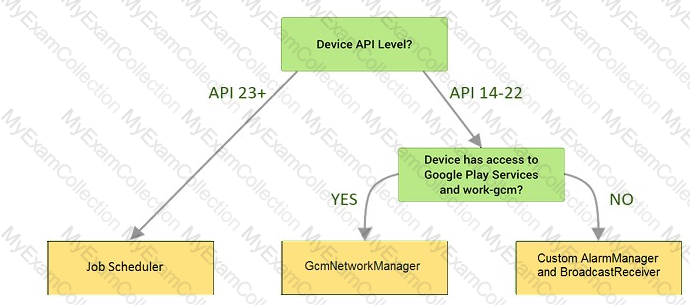As an example. In an Activity we have our TimerViewModel object (extended ViewModel), named mTimerViewModel. mTimerViewModel.getTimer() method returns a LiveData
RecyclerView is a subclass of ViewGroup and is a more resource-efficient way to display scrollable lists. Instead of creating a View for each item that may or may not be visible on the screen, RecyclerView:
Under the hood WorkManager uses an underlying job dispatching service based on the following criteria. You need to move services to the correct places.

Custom views and directional controller clicks. On most devices, clicking a view using a directional controller sends (to the view currently in focus) a KeyEvent with:
Working with Custom View. Once you define the custom attributes, you can use them in layout XML files just like built-in attributes. The only difference is that your custom attributes belong to a different namespace. Instead of belonging to the http://schemas.android.com/apk/res/android namespace, they belong to:
If constant LENGTH_INDEFINITE is used as a parameter for the setDuration method in Snackbar, what will happen?
“workManager†is an instance of WorkManager. Select correct demonstration of WorkRequest cancellation:
For example, we have a file in our assets folder app/src/main/assets/sample_teas.json. To get an
InputStream for reading it, from out Context context, we can try doing this:
Content labels. What attribute to use to indicate that a View should act as a content label for another View?
If you want the Database Inspector to automatically update the data it presents as you interact with your running app, check the Live updates checkbox at the top of the inspector window. While live updates are enabled, what happens with the table in the inspector window?
When your code execution reaches the breakpoint, Android Studio pauses execution of your app. You can
then use the tools in the Debugger tab to identify the state of the app. With Step Out  you can
you can
About running a debuggable build variant. Usually, you can just select the default "debug" variant that's included in every Android Studio project (even though it's not visible in the build.gradle file). But if you define new build types that should be debuggable, you must add ‘debuggable true’ to the build type. Is that mostly true?
What is demonstrated by the code below?
// RawDao.kt
@Dao
interface RawDao {
@RawQuery
fun getUserViaQuery(query: SupportSQLiteQuery?): User?
}
// Usage of RawDao
...
val query =
SimpleSQLiteQuery("SELECT * FROM User WHERE id = ? LIMIT 1",
arrayOf
val user = rawDao.getUserViaQuery(query)
...
In a class PreferenceFragmentCompat. As a convenience, this fragment implements a click listener for any preference in the current hierarchy. So, in what overridden method we can handle that a preference in the tree rooted at this PreferenceScreen has been clicked?
When your code execution reaches the breakpoint, Android Studio pauses execution of your app. You can then use the tools in the Debugger tab to identify the state of the app. With Step Over  you can
you can



